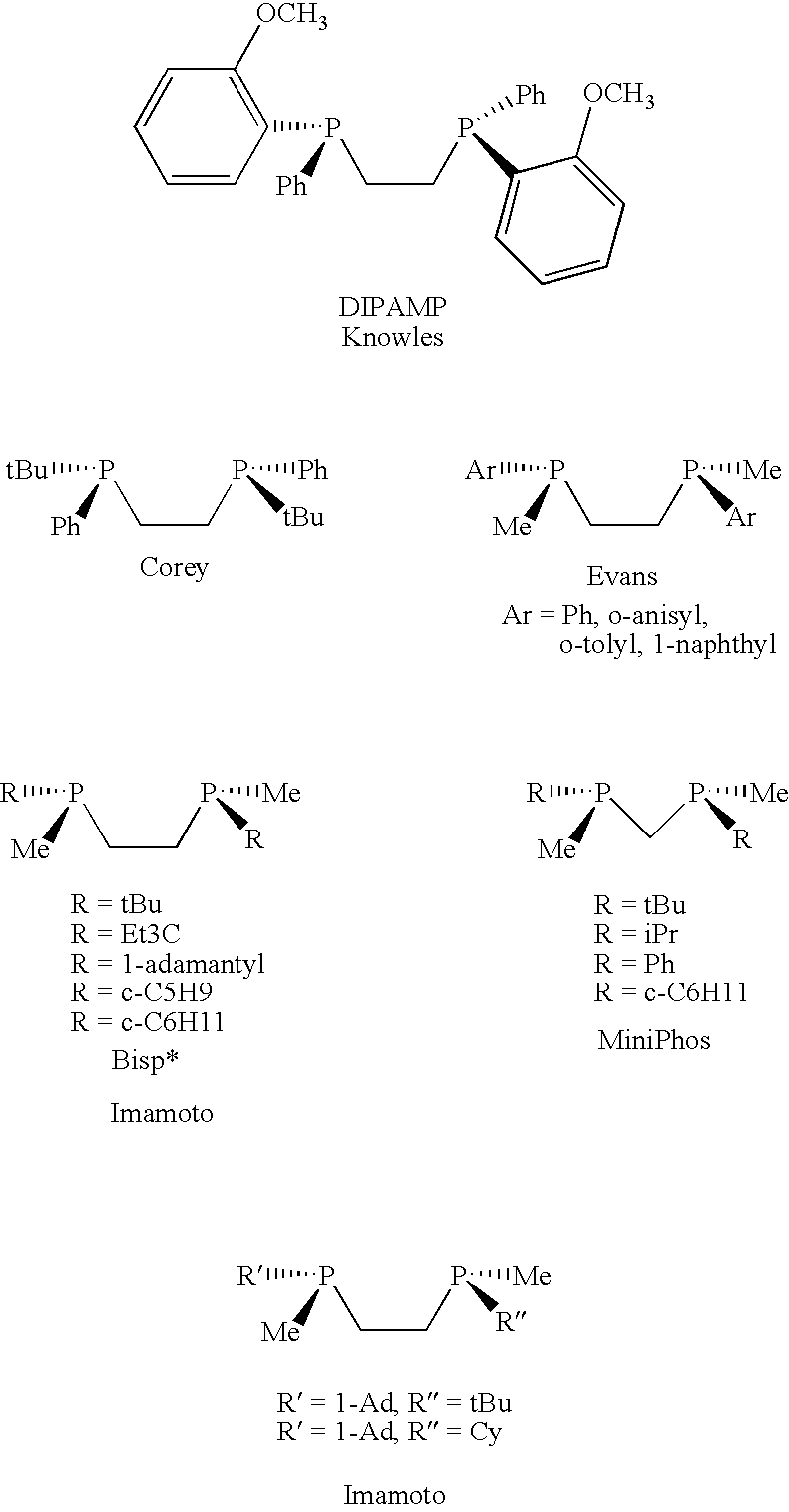P-chiral phospholanes and phosphocyclic compounds and their use in asymmetric catalytic reactions
a technology of phosphocyclic compounds and phospholanes, which is applied in the preparation of optical isomers of carboxylic acid amides, group 4/14 group 7/17 organic compounds without c-metal linkages, etc., can solve the problem of difficult optimization of enantioselectivity and hard prediction of which ligand can be effective for any particular reaction or substrate, and achieve selective in asymmetric cata
- Summary
- Abstract
- Description
- Claims
- Application Information
AI Technical Summary
Benefits of technology
Problems solved by technology
Method used
Image
Examples
example 1
Synthesis of TangPhos (1)
[0196]An efficient three-step synthetic of chiral C2 symmetric P-chiral bisphospholane route has been developed.
Preparation of 1-tert-butyl-phospholane 1-sulfide
[0197]
[0198]Preparation of BrMgCH2(CH2)2CH2MgBr. To a dry Schlenk flask held with magnesium turning (7.92 g, 0.33 mol) in 300 ml dry THF was added dropwise 1,4-dibromobutane (23.7 g, 0.11 mol) in 50 mL of THF at room temperature. The reaction was very exothermic during the addition. After the addition was complete (within 1 h), the resulting dark solution was kept at r.t. for 2 more hours. The whole solution was used directly for the following reaction.
[0199]To a solution of phosphorous trichloride (13.7 g, 0.10 mol) in THF (300 mL) was added dropwise a solution of t-BuMgCl in THF (100 mL, 1.0M) at −78° C. The addition was complete within 2 hrs. After the mixture was stand at −78° C. for 1 h, a solution of BrMgCH2(CH)2CH2MgBr in THF (made above) was added dropwise. The addition was complete within 2 ...
example 2
Asymmetric Hydrogenation of Dehydroamino Acids General Procedure for Asymmetric Hydrogenation
[0210]To a solution of [Rh(COD)2]BF4 (5.0 mg, 0.012 mmol) in THF (10 mL) in a glovebox was added a chiral phosphine ligand (TangPhos 0.15 mL of 0.1 M solution in toluene, 0.015 mmol). After stirring the mixture for 30 min, the dehydroamino acid (1.2 mmol) was added.
[0211]The hydrogenation was performed at rt under 20 psi of hydrogen for 24 h. The reaction mixture was treated with CH2N2, then concentrated in Vacuo. The residue was passed through a short silica gel column to remove the catalyst. The enantiomeric excesses were measured by GC using a Chirasil-VAL III FSOT column.
[0212]The absolute configuration of products was determined by comparing the observed rotation with the reported value. All reactions went in quantitative yield with no by-products found by GC.
[0213]Asymmetric hydorgenation for making alpha amino acid derivatives using TangPhos (1) as the ligand is shown in the Table bel...
example 3
Asymmetric Synthesis of Beta-Amino Acid Derivatives Synthesis of Starting Material 3-Acetamido-3-Aryl-2-Propenoates and 3-Acetamido-3-hetero-Aryl-2-Propenoates
[0215]Typical procedure: The starting material methyl 3-acetamido-3-phenyl-2-propenoate can be conveniently synthesized from cheap acetophenone in three steps according to known literature procedure in good yields. The literatures are Zhu, G.; Zhen, Z.; Zhang, X. J. Org. Chem. 1999, 64, 6907–6910; Krapcho, A. P.; Diamanti, J. Org. Synth. 1973, 5, 198–201. 1H-NMR (CDCl3, 360 MHz) δ (Z isomer) 2.17 (s, 3H), 3.77 (s, 3H), 5.29 (s, 1H), 7.37–7.45 (m, 5H); (E isomer) 2.38 (s, 3H), 3.77 (s, 3H), 6.65 (s, 1H), 7.37–7.45 (m, 5H).
Hydrogenation for Making Beta Amino Acid Derivatives with the Rh-TangPhos (1) System
[0216]
entryaR1R2geom.ceeb(%)config.1MeEtE99.5R2MeEtZ97.3R3Mei-PrE99.3R4EtMeE99.6R5n-PrEtE99.6R6i-BuMeE98.5R7PhMeE / Z93.8S8p-F-PhMeE / Z95.0S9p-Cl-PhMeE / Z92.3S10p-Br-PhMeE / Z95.1S11p-Me-PhMeE / Z94.0S12p-MeO-PhMeE / Z98.5dS13p-BnO-PhMeE...
PUM
| Property | Measurement | Unit |
|---|---|---|
| optical purity | aaaaa | aaaaa |
| optical purity | aaaaa | aaaaa |
| pressure | aaaaa | aaaaa |
Abstract
Description
Claims
Application Information
 Login to View More
Login to View More - R&D
- Intellectual Property
- Life Sciences
- Materials
- Tech Scout
- Unparalleled Data Quality
- Higher Quality Content
- 60% Fewer Hallucinations
Browse by: Latest US Patents, China's latest patents, Technical Efficacy Thesaurus, Application Domain, Technology Topic, Popular Technical Reports.
© 2025 PatSnap. All rights reserved.Legal|Privacy policy|Modern Slavery Act Transparency Statement|Sitemap|About US| Contact US: help@patsnap.com



